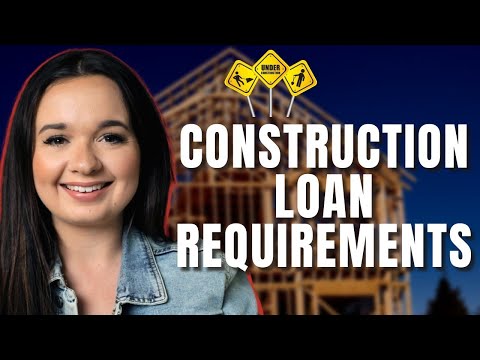When it comes to building your dream home from the ground up or transforming your current abode with a significant renovation, navigating the financial waters can be a tad overwhelming. But don’t fret—let’s dive headfirst into the world of construction loans, providing you with a treasure trove of savvy buyer tips that will make your journey as smooth as a well-oiled door hinge.

The ABCs of Securing a Construction Loan
First things first, let’s break it down. Construction loans aren’t your typical, run-of-the-mill financing options. They’re speckled with unique features designed to fund the creation or major overhaul of your personal castle. Think of them as your financial blueprint for turning soil into sanctuary.
The process? Well, it’s a bit more involved than your average mortgage. Expect to stroll through planning phases where you’ll need to impress lenders with your sharp organization skills—detailed plans and a qualified builder must be in your toolkit. You’ll also need a sturdy credit score, folks. Most lenders are looking for a score around 680, so keep your financial house in order to avoid stumbling blocks on your path to the hammer and nails.
When it comes to project eligibility, not every home-shaped cookie will fit the construction loan mold. There are restrictions, standards, and more hoops to jump through than a circus tiger.

Unlocking the Types of Construction Loans Available
Picture a construction loan buffet—there’s quite the spread. You’ve got your construction-to-permanent loans, whispering sweet nothings about seamlessly transitioning into a mortgage. Then you have the stand-alone construction loans, playing hard to get with their stricter terms and separate mortgage transitions. Both have their raison d’être; it’s all about what dish suits your palate.
And let’s not forget our renovation loans—they’re the trusty sidekick for those not jumping into full-on construction but still aiming for transformation.

| Construction Loan Criteria | Description | Specifics/Notes |
| Credit Score Requirement | Minimum credit score needed for approval. | Typically around 680 or higher. Some lenders may accept a minimum of 620. |
| Down Payment | Initial cash payment made when taking out a loan. | At least 20% down payment is required, with some lenders possibly requiring more. |
| Project Documentation | Necessary paperwork detailing the construction project. | Detailed plans and specifications for the project must be provided. |
| Builder Qualifications | Criteria for the construction professional. | A qualified builder must be lined up to complete the project. |
| Comparison to Traditional Mortgage | How construction loans differ from standard home loans. | Generally harder to qualify for than traditional mortgages. |
| Repayment Terms | Conditions under which the loan must be repaid. | Short repayment term; interest-only payments during construction phase. |
| Over Budget Solutions | Potential remedies when the project exceeds initial cost estimates. | Possibility of securing additional funding if the lender agrees. Consequences depend on loan terms. |
| Usage | The purpose for which a construction loan can be utilized. | Primarily for constructing a residential house for personal use or as an investment. |
| Loan-to-Value | Maximum amount that can be financed relative to the project’s value. | Up to 100% of construction value, max. 90% of market value. Loan may be part of a Home Loan. |
| Debt-to-Income Ratio | Personal financial metric used by lenders to determine borrowing capability. | Lenders analyze DTI ratio, comparing monthly debts to gross monthly income. |
| Benefits | Advantages of choosing a construction loan over other financing options. | Suitable for current homeowners to build anew when lacking enough equity for home equity loan. |
Deep-Dive into the Construction Loan Application Checklist
Roll up your sleeves; it’s time to tackle the paperwork dragon. Get your hands on that credit report, and ensure all is spick and span. Credit scores on the north side of 620 are your ticket in, but 680’s the magic number exuding golden rays of approval chances.
Your financial history will be scrutinized—lenders love a borrower whose debt-to-income ratio plays nice with their gross monthly income. Saddle up with documents galore, and remember, detailed project plans aren’t just pretty pictures—they’re essential puzzle pieces.

Financial Projections: Estimating Your Construction Loan Costs
Budgeting isn’t just for penny pinchers; it’s your financial compass. Calculate those costs down to the last nail and pad that budget for the unexpected. Data says it’s not a case of if costs overrun, it’s when. Thankfully, savvy planning can help avoid a mad scramble for additional funding that’s as comfortable as a porcupine in a balloon factory.

Interest Rates Insights: What to Expect with Construction Loans
Historically speaking, construction loan interest rates can be a seesaw of soaring highs and comforting lows. As we venture into 2024, the crystal ball hints at fluctuations. Our advice? Strategize to snag favorable interest rates and keep those repayments within the realm of your cozy financial blanket.
The Builder’s Perspective: Choosing the Right Construction Team
Selecting a builder isn’t just about finding a crew who can tell a hammer from a screwdriver. You need a squad whose reputation and workmanship shine brighter than a supernova. Due diligence is your bestie here, ensuring your lender gives the thumbs-up without a furrowed brow.
Navigating Construction Loan Inspections and Draws
Welcome to the world of draw schedules and inspection checkpoints. It’s a dance of carefully timed steps, ensuring your project stays tethered to the timeline. A well-managed draw process ensures a smooth sail rather than an unexpected detour through stormy seas.
The Fine Print: Understanding the Terms and Conditions of Your Construction Loan
Let’s talk legal eagles and contractual lingo. Loan agreements are laden with clauses that could make or break your build. It’s about as intricate as a high-stakes game of Jenga. Ignoring the fine print? That’s like wading through a swamp without checking for gators.
From Construction to Mortgage: Transitioning Loan Types Post-Build
The construction phase has wrapped, and now it’s time to morph that construction loan into a more permanent fixture—think of it as a financial chrysalis. This transition requires a new flap of appraisals and maybe even a hurdle or two to vault over. Streamline this process, and you’ll have lucky ducks quacking enviously at your seamless changeover.
Risk Management Strategies to Safeguard Your Construction Loan Journey
Brace yourself for a spot of risk management, less ‘tightrope walker,’ more ‘safety net ensemble.’ Get yourself cocooned in the best insurance products, and know those lien waivers like the back of your hand. Be proactive, foresee potential hiccups, and sidestep them with the agility of a ninja.
Beyond the Basics: Utilizing Construction Loans for Sustainable Building Practices
Sustainable building is the wave of the future, folks. Green building practices? They’re not just for tree huggers. In fact, they could snag you some sweet financial incentives to sweeten the construction loan pot. Be the change, and get that green.
Conclusion: Building Mastery – Expert Takeaways on Construction Loan Savvy
We’ve journeyed through the thicket of construction loans like seasoned adventurers, uncovering crucial insights to fortify your financial quest. The construction loan world is ever-evolving, so plant your feet firmly in the knowledge soil we’ve tilled together.
Embrace these essential tips, and you’re not just building a home—you’re crafting a financial stronghold. Go out there and build boldly; Mortgage Rater has equipped you with the armor to conquer the construction loan dragon!
(Alt text examples incorporating provided links could be: “When evaluating builders, start by doing your homework and look for an exceptional track record akin to Madeline Kingsbury mn. or “Choosing the right loan can be as crucial as selecting an innovative business model, much like Alphabet Google.)
Unlocking the Secrets of a Construction Loan
Are you excited to dive into the world of building your dream home from the ground up? Well, grab your hard hats, folks, because we’re about to lay the foundation of knowledge about construction loans, brick by fascinating brick!
Just Like Running Shoes, You Need the Right Fit
Picture this: Just as you wouldn’t hit the pavement for a marathon wearing flip-flops, entering the race to build a home requires the proper financial footwear. Let’s talk about finding a construction loan that fits just right, much like a pair of brooks glycerin 19 sneakers – designed for comfort and to support you every step of the way.
A Quotation for Inspiration
Building a home is no small adventure. It’s a journey that requires patience, dedication, and a sprinkle of magic. Think of it like a classic disney Quotes scenario – “If you can dream it, you can do it! Keep that spirit alive as we hammer out the details of your construction loan.
Size Matters: The Conforming Loan Conundrum
When sizing up for a construction loan, it’s crucial to understand whether you’re working within the boundaries of a “Conforming Loan” or if you’re stepping outside those lines. Just as Cinderella’s slipper had to fit perfectly, so does your loan need to match the guidelines set by Fannie Mae and Freddie Mac.
Expect the Unexpected: The Contingency Concept
Oh boy, construction can sometimes throw you curveballs, and that’s where having a “Contingency” fund comes in handy. It’s like the secret pocket in a magician’s cloak – you don’t know it’s there until a rabbit needs to appear. This safety net factor is built into your loan so that when surprises pop up—and believe me, they will—you’re covered!
Now, remember, when it comes to construction loans, it’s not just about having a clear blueprint. It’s about understanding the terrain, wearing the right gear, and marching onward with a touch of fairy-tale wisdom and practical magic. So strap on your best financial boots, and let’s build not only houses but dreams!

Why are construction loans hard to get?
Oh boy, landing a construction loan is like trying to hit a moving target! They’re tough to wrangle because lenders see them as riskier than your run-of-the-mill home loans. You’re essentially asking them to fork over cash for a place that’s more idea than reality. Plus, with no home to use as collateral if things go sideways, banks are a little jittery about where they put their money.
Is a construction loan easier to get than a home loan?
Don’t bet the farm on it, but snagging a construction loan is generally trickier than getting a traditional home loan. While home loans are secured by the existing property, construction loans are based on a project that hasn’t been built yet, making lenders as nervous as cats in a room full of rocking chairs.
What are the benefits of a construction loan?
One of the sweet perks of a construction loan is it lets you call the shots. The ball’s in your court to design your dream home from the ground up! And another thing, these loans can cover a boatload of expenses, like land, labor, and materials—sort of a one-stop shop for all your building needs.
What happens when you go over budget on construction loan?
Well, ain’t that a pickle? Going over budget can be a real headache. If your construction costs balloon and you’re scrabbling for change under the couch cushions, you might need to renegotiate your loan terms. Worse comes to worst, you might have to reach into your own pockets to cover the extra. Not fun!
What is a good credit score for a construction loan?
Shoot for the stars, or at least aim for a credit score north of 680. That’s generally seen as the sweet spot for a good construction loan credit score—pretty much your financial report card telling lenders you’re likely to pay them back without a hitch.
What is the primary disadvantage of a construction permanent loan?
If there’s a fly in the ointment of construction permanent loans, it’s that they can lock you into a higher interest rate. If rates drop after your loan converts from the construction phase to the permanent phase, you might be stuck paying more than if you’d gotten a traditional mortgage with a fixed rate from the get-go.
Are construction loan rates higher than mortgage rates?
Well, it’s not exactly apples to apples, but generally, construction loan rates are prone to be higher than mortgage rates. It’s the price you pay for the flexibility to build your castle your way. As they say, no pain, no gain, right?
What is an example of a construction loan estimate?
Imagine this: You’re looking at a construction loan estimate, and it’s like a crystal ball into your project’s financial future. It would include the estimated costs for materials, labor, and permits—sort of a roadmap showing you the dollars and cents of bringing your blueprint to life!
Is it cheaper to buy a house or build a house?
It’s the million-dollar question, huh? Whether it’s cheaper to buy or build a house depends on a ton of factors—like location, materials, and design. Sometimes you hit the jackpot buying an existing home, other times building can save you a bundle if you play your cards right.
What are the downsides of construction loans?
The downsides of construction loans are a bit like a thorn in your side. They’re short-term, high-interest, and can be as unpredictable as the weather. And, unlike a traditional mortgage, you’ve got to manage the construction chaos while making sure your financial ducks stay in a row.
What are the risks of a construction loan?
Construction loans are like walking a tightrope without a net; the risks are sky-high. You’re betting on a project that’s yet to be completed, and if things go south—like construction delays or cost overruns—you could be left holding a very expensive bag.
How do you explain a construction loan?
Breaking down a construction loan is simpler than it sounds. It’s basically your financial BFF for building a house. You borrow the moolah to pay for the construction, and then it turns into your regular mortgage once your dream home is all set up. It’s like a caterpillar morphing into a butterfly!
What is the debt to income ratio required for a construction loan?
The debt to income ratio is like your financial balancing act. For construction loans, lenders often want it to be 45% or less. They want to make sure your wallet isn’t stretched thinner than a piece of spaghetti before they give you the green light.
Will construction costs go down if there is a recession?
Well, isn’t economics a hoot? If we hit the skids and a recession rolls around, construction costs could take a nose dive. But it’s a bit like trying to predict the weather—sometimes spot-on, sometimes, well, not so much. In theory, less demand could mean lower prices, but don’t bet the house on it.
What is the difference between a construction loan and a mortgage?
It’s like comparing apples and oranges, really. A construction loan is there to fund the whole dog and pony show of building a house, and you only make interest payments until it’s done. A mortgage, on the other hand, is the long-term financing you repay with interest for a house that’s ready to move into.
Is it hard to get a loan as a contractor?
Trying to get a loan as a contractor can be like trying to nail Jell-O to a wall—it’s doable, but it sure ain’t easy! Lenders can be a bit leery since contractors’ income might flutter like leaves in the wind, so having a solid financial history and a stellar credit score can be real game-changers.
What is an example of a construction loan estimate?
Picture this: A construction loan estimate would list out all the expected costs you’re gonna meet head-on, like Bob the Builder on a mission—from the bulldozing to the doorknobs. Think itemized numbers for supplies and labor, a total loan amount, and a pretty accurate guess at your future monthly payments.
How is construction loan interest calculated?
The math for construction loan interest can make your head spin, but it boils down to this: You generally only pay interest on the money that’s been doled out so far. This interest is often variable, ticking away like a meter in a taxi, based on what you’ve actually borrowed during construction.
What is a balloon period?
A balloon period is when you’re kicking the can down the road, only paying interest for a time. But watch out! When that period’s up, you’re on the hook for the full loan amount—sort of like finishing your dinner only to find you still have to eat your veggies.




